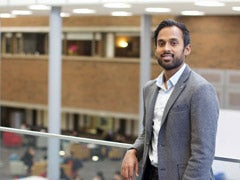
Do skyscrapers stress you out?
Psychology researcher is examining how dense urban areas affect our physical and mental health

Psychology researcher is examining how dense urban areas affect our physical and mental health
By Claire Prime Faculty of Arts
FiledIMAGE/iStock/Thinkstock
A well-designed city is not just accessible, functional and attractive, it should make us happy too, says University of Waterloo doctoral candidate Robin Mazumder.
With more than 80 per cent of the population now living in urban areas, Mazumder’s research has far-reaching implications for the well-being of Canadians. In collaboration with Professor Colin Ellard of the Urban Realities Laboratory, Mazumder is studying how urban design affects mental health — in particular, the psychological and physiological effects of living or working near skyscrapers.
“If we know that people are stressed by being in the presence of skyscrapers or dense urban centres, then it’s a question of public health,” said Mazumder. “It’s not that being in the presence of a skyscraper for five minutes is going to cause you to keel over, but it’s a question of chronic exposure.”
His research captured the attention of the Kitchener Public Library (KPL), where he is a guest librarian. As part of his role at the library, Mazumder will be presenting a panel discussion on how cities contribute to our health. Panelists will include Ellard, Dr. Leia Minaker from the School of Planning and Rod Regier, commissioner of Planning, Development and Legislative Services for the Region of Waterloo. The public is welcome to register for the event, which takes place on January 18 at 7 p.m. at the Kitchener Public Library Central branch.
Before starting his PhD in psychology, Mazumder was a mental health occupational therapist working in Toronto and Edmonton, where he saw first-hand how planning affects our cities’ most vulnerable people. Through his work, he helped people suffering from mental illness improve their immediate environments, but he couldn’t change the cities they were living in.

Waterloo Psychology researcher Robin Mazumder
While living in Edmonton, Mazumder began working with a suicidal man living in the suburbs on the outskirts of the city. The man was lonely. “I said, ‘Let’s go out and explore your community and see where we can meet people,’ but there really wasn’t anything.”
It was a pivotal moment. Mazumder was both teaching occupational therapy at MacEwan University in Edmonton and working as a therapist, but he longed to learn more about the impact of urban design on our psyches. He had read Charles Montgomery’s Happy City, a book greatly informed by research done at Waterloo, years earlier, but it wasn’t until he saw Ellard’s article on boring streets that he got in touch. The two connected right away. Mazumder started his PhD in January 2016.
For his thesis, Mazumder fits participants with virtual reality headsets that show a cityscape. As they look around, their blood pressure, heart rate and sweat are measured and they’re asked questions about their environment and mood. The goal is to understand how city towers affect stress and to identify potential solutions. Adding greenery might help reduce feelings of anxiety, for instance, he said.
“Because cities are trying to combat urban sprawl, they’re building upwards,” said Mazumder. “Cities can’t just stop building skyscrapers, so we’re looking at how to use design to mitigate those stressful effects.”
He has also worked, in collaboration with Ellard and author Montgomery, on an experiment in Vancouver, where participants were asked to answer questions as they walked through particular neighbourhoods. Though the data is still being analyzed, Mazumder said people seem to respond positively to nature, seating areas and public art. The team is working to make the results of that experiment accessible to residents and policy makers. “The collaborative report for the public is just as important as a scientific journal publication,” Mazumder said.
Beyond his research, Mazumder is dedicated to building a happier city in his own community too. He has sat on a number of boards and task forces dedicated to addressing the needs of refugees and immigrants and eliminating poverty, among other goals. In Edmonton, he brought light therapy lamps for those suffering from Seasonal Affective Disorder to public libraries and created a pop-up bike lane to advocate for safer streets for cyclists. He has worked with youth with disabilities in Victoria and Russia, where he developed recreational programming at an orphanage.
Since moving to Kitchener, Mazumder has found his niche. He has joined the University of Waterloo Senate and worked as a GRADventure specialist, helping graduate students explore alternative career paths. He has been prolific on social media, blogging and tweeting about a variety of topics including cycling infrastructure, mental health and snow maintenance.

Read more
Researchers awarded funding to investigate ecology, climate change, repatriation, health and well-being through cultural and historical lens

Read more
New Canada Research Chairs will tackle future-focused problems from social robots and intergroup attitudes to geochemistry and nanoscale devices

Read more
Meet five exceptional Waterloo graduate students crossing the convocation stage as Class of 2025 valedictorians
The University of Waterloo acknowledges that much of our work takes place on the traditional territory of the Neutral, Anishinaabeg, and Haudenosaunee peoples. Our main campus is situated on the Haldimand Tract, the land granted to the Six Nations that includes six miles on each side of the Grand River. Our active work toward reconciliation takes place across our campuses through research, learning, teaching, and community building, and is co-ordinated within the Office of Indigenous Relations.